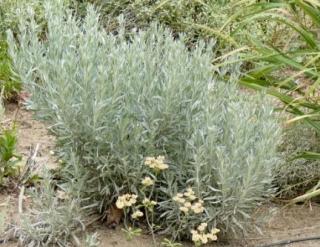Artemisia cana in the Landscape

Laura Smith Westscape Nursery, Bozeman, Montana.
Scientfic Name: Artemisia canaCommon Name: Silver Sagebrush, Mountain Silver Sagebrush, Bolander Silver Sagebrush.
Description: Artemisia cana is an evergreen subshrub to shrub 2-5' tall dependent on location and elevation. A. cana spp. bolanderi (Bolander Silver Sagebrush) grows up to 3', A. cana spp. viscidula (Mountain Silver Sagebrush) is short only growing to 1' and A. cana (Silver Sagebrush) can grow up to 5'. Intense blue foliage during the spring conditions. The aromatic, soft texture of the long leaves lends this sage to landscapes. Spreads slowly by rhizomes.
Native Habitat: Silver Sagebrush grows in moist meadows and slopes ranging from foothills to higher elevations. This shrub tolerates a wide range of soil types and moisture regimes. It is often associated with forbs and low growing grasses.
Cultural Requirement
Soil: Range from coarse to fine textures and pH ranges slightly acidic to alkaline. Does not tolerate clay soils. Avoid saline soils although poorly drained alkaline soils are tolerated by spp. bolanderi.
Moisture Tolerance: Range from annual precipitation of 8"-40". Tolerates seasonal flooding and drought.
Sun/Shade/Preference: Requires full sun and has very low shade tolerance. Requires full sun for seed establishment.
Transplanting: Is relatively easy during the spring and summer from containerized material and bare root (spring only). Avoid winter and late fall transplanting.
Propagation: Easiest by seed.
Maintenance (pruning, fertilization, deadheading, division, irrigation, etc): Silver Sagebrush can be pruned and tends to regrow lusher. Tolerates hedging. Tolerates moderate fertilization but does not tolerate salt.
Insect, disease, or other problems: Can be susceptible to foliar and root pathogens such as Powdery Mildew and Fusarium root rot. Check for aphids especially in the early spring.
Landscape Value
Foliage: Lovely blue color.
Flower: Inconspicuous flowers.
Timing: Apr May June July Aug Sept Oct
Form: Erect shrub.
Ultimate Size: 1-5' depending on conditions and subspecies.
Rate of Growth: Medium dependent on moisture and temperature.
Suggested Plant Partners: Low growing bunch grasses and perennials.
Availability: Good in native and specialty nurseries. Subspecies may be hard to find.
References:
Munshower, F.F. 1995. Forbs, shrubs, and trees for revegetation of disturbed lands in the northern Great Plains and adjacent areas. Montana State University, Reclamation Research Unit Publ. No. 9505
Rose, R, C.E.C. Chachulski, and D.L. Haase. 1998. Propagation of Pacific Northwest native plants. Oregon State University Press. ISBN 0-87071-428-7
USDA Plant Database

